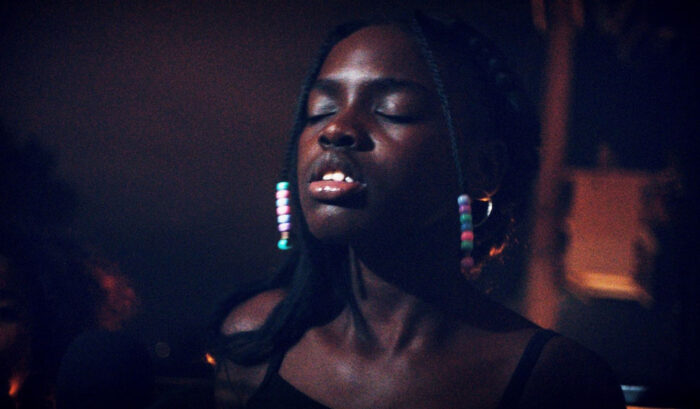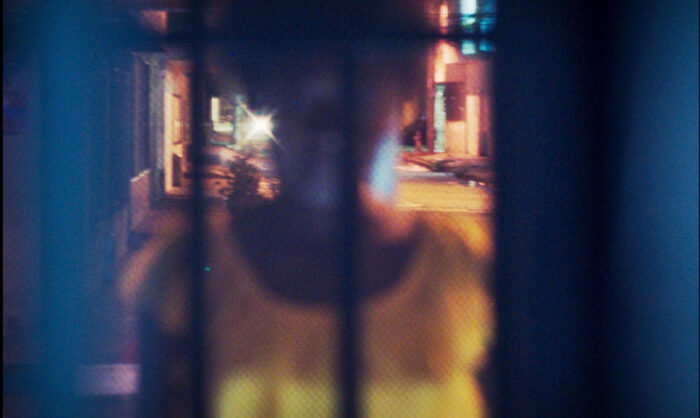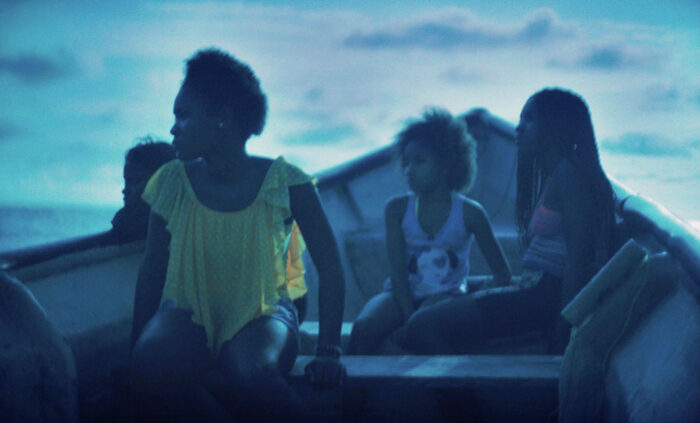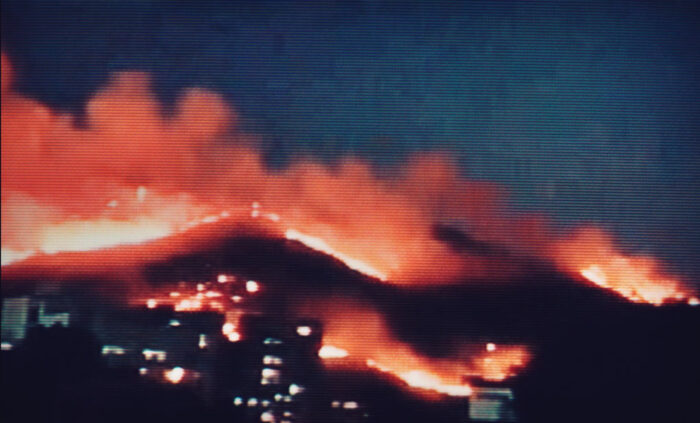The Sound of the Ocean
An introduction to Camila Beltrán’s “Pacífico Oscuro”
As part of its current programme Shuttering and Healing (16 May — 22 October 2021), DEMO presents Pacífico Oscuro, a film by Camila Beltrán, which investigates sonic cultures and mystical practices of the Black Colombian Pacific. Pacífico Oscuro is currently on view on the platform DEMO – Moving Image Experimental Politics.
DEMO is a curatorial platform exploring the aesthetic and political potentialities of the moving image. Regularly presenting artists’ films, the aim is to shed light on overlooked events and bring forth new narratives concerning subaltern conditions, as well as to speculate on alternative modes of coexistence.
Prelude: a wet context
“We find ourselves tangled in intricate choreographies of bodies and flows of all kinds—not only human bodies, but also other animal, vegetable, geophysical, meteorological, and technological ones; not only watery flows, but also flows of power, culture, politics, and economics”—says the gender and culture scholar Astrida Neimanis, a prominent voice in the hydrofeminist discourse. Hydrofeminism is a mode of posthuman phenomenology which revises the liminal boundaries that define our bodies. The author, who has long been “thinking with water,” advocates for a “trans-corporeal approach,” an understanding of our bodies as fundamentally intertwined with the natural world, not separate from nor privileged to it. Neimanis writes from the material perspective of water to speak of larger ecosystems. She points to the far-reaching potential of this fluid to indicate a new way toward ecological cognition, as “not only does water connect us, gestate us, sustain us—more than this, water disturbs the very categories that ground the domains of social, political, philosophical, and environmental thought.”
Water is the element that ties human beings to their surrounding world, from the oceans around us to the water that makes up most of our bodies. Its intrinsic properties, including fluidity, mobility and cohesion, make it a vector capable of change—a “wet medium.” Water morphs, shapes-shifts, and has life-giving potentiality. It persistently overflows any attempt at capturing, as it takes up a whole universe of symbolic meaning alongside its material properties.

Similar things can be said of sound. Of a voice, a chant, a whispered story. Materially, sound acts much like water: acoustics come in waves, spread out in ripples, reaching corners, trespassing solid boundaries. Like water across oceans, sonorities travel long distances, flowing down rivers and through bodies, setting us adrift in space-time, between sensorial certainties and blurred histories. Oral stories can survive centuries and reverberate through time. As ethnomusicology professor Ana Maria Ochoa Gautier says, while reflecting on the role of voices in shaping the notions of nature and culture, sound is “a force that constitutes the world and a medium for constructing knowledge about it.”
If water and sound embody agential properties, an entanglement of the two is called into question to provoke disturbances in the flows of power and culture, politics and economics, and to bring other worlds to the surface. But how do we observe this in practice?
Take a body of water like the Ocean Pacific. More specifically a corner of it, the Colombian Pacific region, a highly aqueous terrain crossed by over two hundred rivers flowing from the mountains to the ocean. Inhabited by approximately forty per cent of the Colombian population, the area hosts indigenous groups and a majority of Afro-Colombians, descendants of slaves brought from Africa, who have maintained specific material cultural practices which tie them to the territory. In addition to having been removed from their native homelands at the beginning of the 17th Century, the Black diasporic communities, and other groups who have traditionally inhabited these areas, are again facing displacement. Currently, some are collectively organising against the rapid advancement of economic powers and political agents invading the region. Many others have relocated to nearby cities and towns. Colombian anthropologists Arturo Escobar and Mauricio Pardo write about the area’s unprecedented changes, as “large scale development plans, new fronts opening for capital accumulation (such as African palm tree plantations and shrimp nurseries), and numerous indigenous and black mobilizations. Within this emerging imaginary, the Colombian Pacific region occupies an important place as a launching platform for the macroeconomy of the future. The discovery of biodiversity in this region is one of the main components of this new imaginary.”

In the complex Colombian-Pacific scenario of land appropriation, extractivism, and community struggle for ecological preservation and heritage survival, Camila Beltrán’s film Pacífico Oscuro presents a different type of imaginary. It delves into the long-standing musical tradition of the region and the mysticism of the African diaspora—ancient practices that still survive to this day. By combining ancestral sounds of Afro-Colombians with the hydro-logic of the Pacific, the film subtly discloses potentiality for resilience, re-existence, and ecological cognition.
Aquatic histories, acoustic assemblages, and identity de-formation
Shot along the coast of the Colombian Pacific Ocean and in the city of Cali, the film presents contrasting landscapes imbued in mystery: run-down urban neighbourhoods, forested lands on fire, seen both on TV and in real life, and the film’s titular ocean, with its inhabitant. Among the events—all visually connected by a crawling black crab that acts like a fil rouge, linking various scenarios—the ocean is a protagonist, dark and obscure. And yet, it gives solace—much like sounds. Groups of young adults and children, mainly girls, play and sing in music groups. When night comes, they sail on the ocean, walk away from wildfires, and encounter sinister marine creatures. The voice of an older woman reveals stories of women “who used to make pacts with mystical forces to master the art of singing.” She points to a practice that is gradually disappearing. And with it, a connection with some ancient knowledge, which leaves a space for anger and damnation to fill as it vanishes.
The film is not science fiction, but like the best from this genre, it sparks from facts that are very real. Shot in Super 8 mm film and in an aesthetic that recalls that of archival footage, the images present something which is, in fact, rare and about to be lost: a symbiotic relationship between humans, other animals and sea entities, mystical forces, and territories; a relationship that is innate in Black and indigenous communities who have traditionally inhabited these watery lands.

This interconnection between different forms of life and territories emerges in numerous local traditions and forcefully in musical production. For example, the vocalisations and scattered intonations in the film evoke the howling sounds of bogas—songs performed by Afro-Colombian boat rowers to the rhythm of water while navigating the Magdalena River or the ocean. These sounds not only bring with them a connection with the ancestral—through the use of marimbas and other percussion instruments that were brought in Latin America by the African diaspora—and the territory, which is not to be intended as a fixed land but as a fluid terrain that expands over borders. By drawing from material properties of water and its rhythms, sound embodies powerful connections along with potential for fluid identities.
With their capacity to disembody, voices confuse the boundary between different species and worlds, and give the possibility to re-think identity from a non-human perspective. In the past, Bogas were described by travellers as a mode of howling comparable to the voices of different animals. As Ana Maria Ochoa Gautier reported, these vocalisations sounded out of tune and difficult to classify as either language or song. The human voice—from a Creoles and European perspective—is what distinguished men from animals, and mixing it up with animal sounds was the sign of a “lowly human condition.” Instead, for indigenous people, the voice was not understood as a representation of their identity but as something that allowed them to shift between different modes of being. Or as Ana Maria Ochoa Gautier puts it “the voice manifested or enabled the capacity to move between states of multiplicity or unity where a single person can embody multiple beings and where collective singing, as in a feast, can manifest a unity in which the collective is understood as expressing the singular.”

Another example, perhaps more symbolic, of this environmental and cultural interconnection is the song Parió La Luna, a traditional children song performed in the film by the young music group, which speaks of the moon giving birth. The words, uttered in Spanish, blur the distinction between animal, celestial bodies and Circadian rhythms. As sonorities and natural territories intertwine and influence each other, they become the ephemeral agents for the union of human and non-human identities, and various forms of life.
By presenting music and sounds that pass on from generation to generation, and that embody a multiplicity of voices, the film allows for plurality to proliferate, to evoke different agents speaking, and enact a form of re-existence, both for the spirits of those who have gone, those who are still present and (hopefully) for those yet to come.
Connecting with the territory: sonic healing, mysticism and re-existence
An urgency to remember is at the core of the film. But also a consciousness that is ancient, ineffable or hard to retrieve. As the filmmaker explained in a recent discussion [Sonic Healing and Ancestral Rituals from the Missing Channel. Camila Beltrán in conversation with Giulia Civardi, DEMO Podcast Series], what is disappearing is both cultural and ecological . In fact, Helena, the invisible narrator in the film, is an example of the last generation of women who grew up directly connected to a deep knowledge of the territory and its unspoken laws. This is because younger generations are growing up in cities with no relationship to water and rivers. Beltrán’s statement strongly resonates with what Michael Taussig wrote in relation to the “disappearance of the sea”—“Today we relate to the ocean and its histories through the commodities brought in the hulls of ships.” One might add that the commodities in question do not exclude human bodies.
When we are to face environmental realities and their disappearance, in a process that is simultaneously cultural and socio-political, we may need to re-look at local communities, human activities and rituals of a region such as the Colombian Pacific to further understand the deep relationships between water systems and ecological thinking. The importance of these sounds, in fact, is fully recognised. In 2014, traditional acapella chants were declared “immaterial heritage of the Colombian Nation” by the national heritage council. Marimba music has been listed on UNESCO as an intangible part of Colombian culture. And, every year local communities gather for the Petronio Music Festival. These sounds and rituals are preserved for their power to heal, to remember and perform ongoing resilience.
In a context where populations are gradually falling out of sync with the territory around them, it is important to think of the Ocean as “a planetary archive of meaning and matter”—to borrow Neimanis’ words. These ancient sounds emerging from waters, help to connect with a wider, systemic understanding of interrelations.
Voices and noises take over the senses, reorganising how we perceive, feel and understand. The cinema trance technique used in the film also contributes to confuse the picture, of a vanishing world, and to see clearly via other means. Entanglements of sound, the aquatic and images combined provided the link which challenged the separation between nature and culture, powerfully reuniting the two.
“Whoever listens to this story without having lived it will not believe it. But it is true”, says the invisible narrator in the film. There is an urgency to remember, but also to tune in and listen; from a breath that gives voice to a song to the rhythms that compose an ecosystem.





